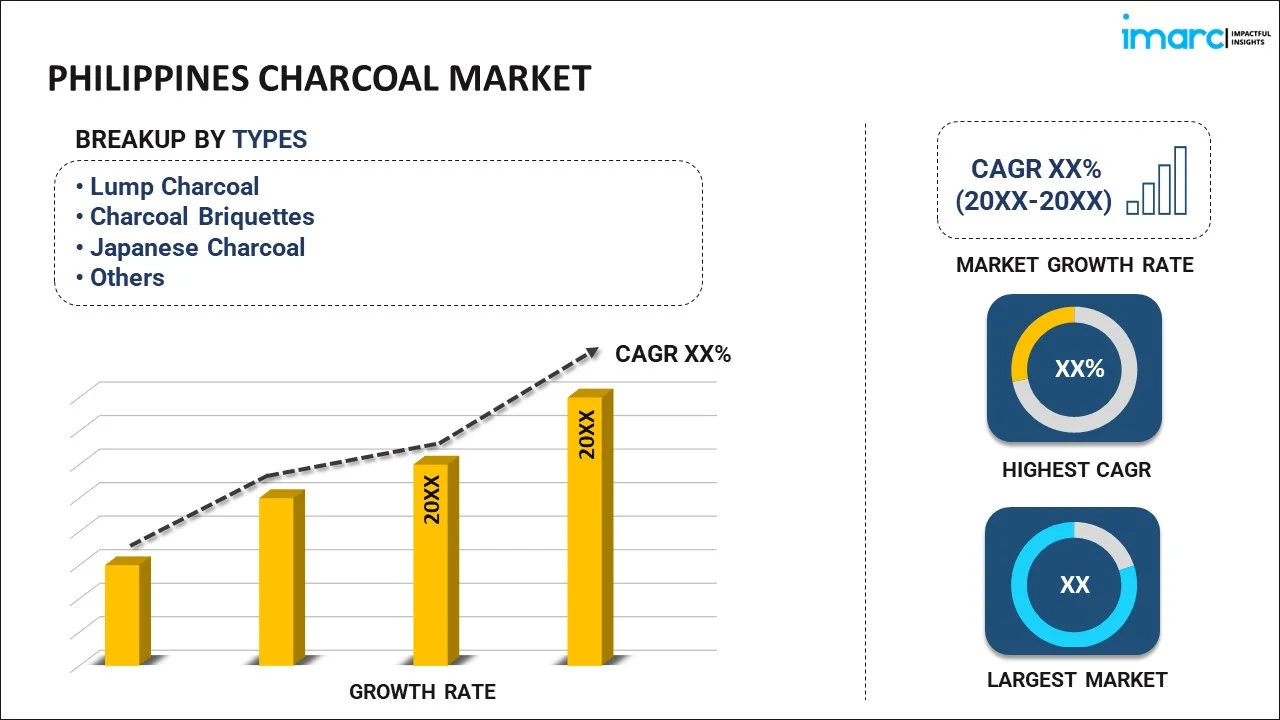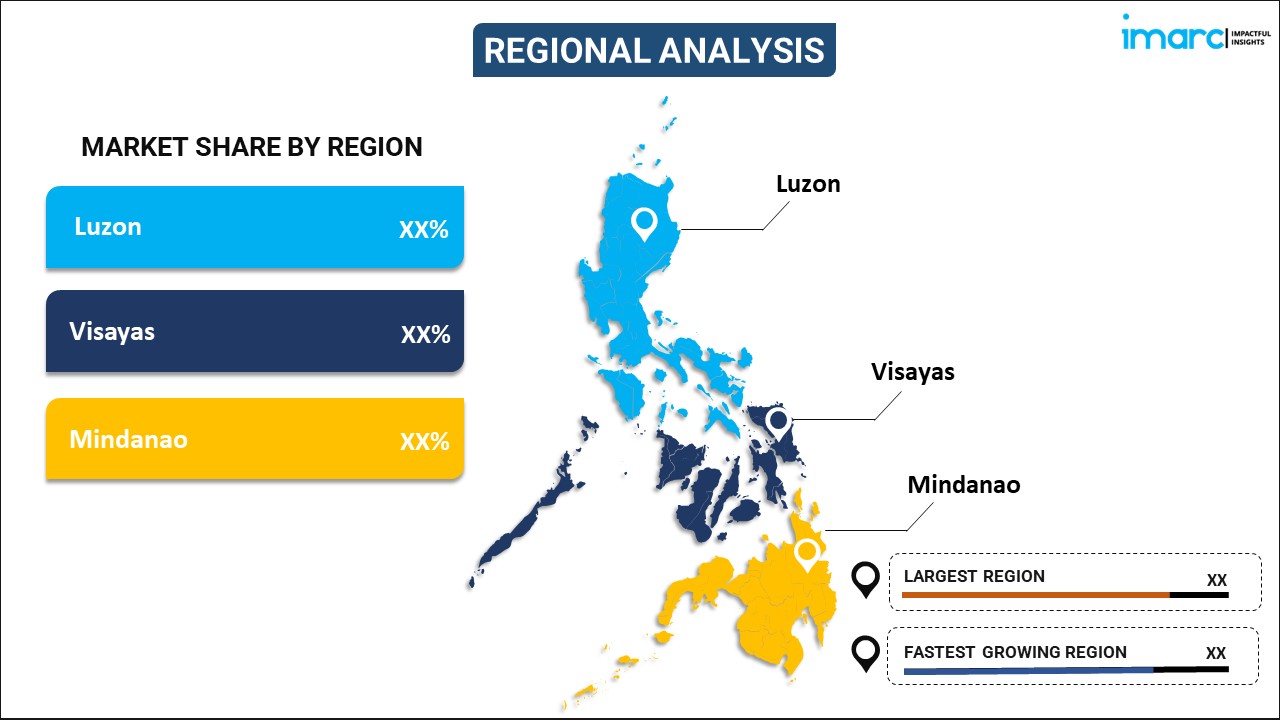
Philippines Charcoal Market Report by Type (Lump Charcoal, Charcoal Briquettes, Japanese Charcoal, Sugar Charcoal, and Others), Application (Metallurgical, Cooking Fuel, Industrial, Filtration, and Others), and Region 2024-2032
Philippines Charcoal Market Overview:
The Philippines charcoal market is projected to exhibit a growth rate (CAGR) of 3.50% during 2024-2032. The market is driven by increasing demand for activated charcoal in health, beauty, and industrial applications, and a shift toward sustainable production practices, enhancing both environmental conservation and economic opportunities for rural communities.
|
Report Attribute
|
Key Statistics
|
|---|---|
|
Base Year
|
2023 |
|
Forecast Years
|
2024-2032
|
|
Historical Years
|
2018-2023
|
| Market Growth Rate (2024-2032) | 3.50% |
Philippines Charcoal Market Trends:
Growing Demand for Activated Charcoal Products
The Philippines is witnessing a surge in demand for activated charcoal products, driven by their expanding applications in health, beauty, and industrial sectors. According to the Philippine Statistics Authority (PSA), the beauty and personal care market in the Philippines grew by 8.3% in 2022, with natural and organic products gaining popularity among consumers. Additionally, a report by the Department of Trade and Industry (DTI) highlights that the market for health supplements, including detox products containing activated charcoal, expanded by 6.5% in the same year. Activated charcoal's popularity in personal care products such as facial masks, toothpaste, and detox supplements is rising due to its purported benefits in skin care and detoxification. The beauty and personal care market in the Philippines has grown significantly, with consumers increasingly seeking natural and effective products. Additionally, activated charcoal's application in water purification and air filtration systems has escalated its demand, as the country faces environmental challenges and aims to improve public health standards.
Expansion of Sustainable Charcoal Production
Sustainable charcoal production is emerging as a significant trend in the Philippines, driven by both environmental concerns and economic opportunities. According to a study published in the Journal of Environmental Science and Management, charcoal contributes only 2.2% or roughly 5.5 million Barrels of Fuel Oil Equivalent (MMBFOE) of the Philippine energy demand on a national scale. Traditional charcoal production methods, often associated with deforestation and carbon emissions, are being replaced by more sustainable practices. The government, in collaboration with non-governmental organizations and private sectors, is promoting the use of agroforestry and sustainable wood sources. These practices help in reducing environmental impact and ensure a steady supply of raw materials. Furthermore, innovations in charcoal production technologies, such as improved kilns and carbonization processes, are enhancing efficiency and yield. These advancements reduce waste and emissions, aligning with the country’s environmental conservation goals. The rise of sustainable charcoal production presents economic benefits for rural communities, providing alternative livelihoods and promoting socio-economic development.
Charcoal for purification
The Philippines charcoal market is experiencing a notable surge in demand for specialty charcoal products beyond traditional applications. Alongside the rise in sustainable charcoal production, there is a growing appetite for innovative uses such as activated charcoal products for skincare, water filtration, and air purification. This diversification is reshaping the market landscape, catering to health-conscious consumers and industries seeking eco-friendly alternatives. According to the Royal Society of Chemistry, due to its significant surface area, AC is frequently utilized for a variety of purposes, including removing impurities from air and water. As these trends continue to evolve, the charcoal market in the Philippines is poised for dynamic expansion, driven by both sustainability initiatives and innovative product development.
Philippines Charcoal Market News:
- April 13, 2023: Philippines’ first automated eco-friendly Bana Grass Charcoal Facility worth P30 million is set to rise in Ayungon town. With the establishment of the factory, the Van Kessel-Mackay Green Energy Company is expected to employ over 20,000 workers to do the planting of bana grass in a 400-hectare land as well as making green charcoal as source of income.
Philippines Charcoal Market Segmentation:
IMARC Group provides an analysis of the key trends in each segment of the market, along with forecasts at the country level for 2024-2032. Our report has categorized the market based on type and application.
Type Insights:

- Lump Charcoal
- Charcoal Briquettes
- Japanese Charcoal
- Sugar Charcoal
- Others
The report has provided a detailed breakup and analysis of the market based on the type. This includes lump charcoal, charcoal briquettes, japanese charcoal, sugar charcoal, and others.
Application Insights:
- Metallurgical
- Cooking Fuel
- Industrial
- Filtration
- Others
A detailed breakup and analysis of the market based on the application have also been provided in the report. This includes metallurgical, cooking fuel, industrial, filtration, and others.
Regional Insights:

- Luzon
- Visayas
- Mindanao
The report has also provided a comprehensive analysis of all the major regional markets, which include Luzon, Visayas, and Mindanao.
Competitive Landscape:
The market research report has also provided a comprehensive analysis of the competitive landscape. Competitive analysis such as market structure, key player positioning, top winning strategies, competitive dashboard, and company evaluation quadrant has been covered in the report. Also, detailed profiles of all major companies have been provided.
Philippines Charcoal Market Report Coverage:
| Report Features | Details |
|---|---|
| Base Year of the Analysis | 2023 |
| Historical Period | 2018-2023 |
| Forecast Period | 2024-2032 |
| Units | US$ Million |
| Scope of the Report | Exploration of Historical and Forecast Trends, Industry Catalysts and Challenges, Segment-Wise Historical and Predictive Market Assessment:
|
| Types Covered | Lump Charcoal, Charcoal Briquettes, Japanese Charcoal, Sugar Charcoal, Others |
| Applications Covered | Metallurgical, Cooking Fuel, Industrial, Filtration, Others |
| Regions Covered | Luzon, Visayas, Mindanao |
| Customization Scope | 10% Free Customization |
| Post-Sale Analyst Support | 10-12 Weeks |
| Delivery Format | PDF and Excel through Email (We can also provide the editable version of the report in PPT/Word format on special request) |
Key Questions Answered in This Report:
- How has the Philippines charcoal market performed so far and how will it perform in the coming years?
- What has been the impact of COVID-19 on the Philippines charcoal market?
- What is the breakup of the Philippines charcoal market on the basis of type?
- What is the breakup of the Philippines charcoal market on the basis of application?
- What are the various stages in the value chain of the Philippines charcoal market?
- What are the key driving factors and challenges in the Philippines charcoal?
- What is the structure of the Philippines charcoal market and who are the key players?
- What is the degree of competition in the Philippines charcoal market?
Key Benefits for Stakeholders:
- IMARC’s industry report offers a comprehensive quantitative analysis of various market segments, historical and current market trends, market forecasts, and dynamics of the Philippines charcoal market from 2018-2032.
- The research report provides the latest information on the market drivers, challenges, and opportunities in the Philippines charcoal market.
- Porter's five forces analysis assist stakeholders in assessing the impact of new entrants, competitive rivalry, supplier power, buyer power, and the threat of substitution. It helps stakeholders to analyze the level of competition within the Philippines charcoal industry and its attractiveness.
- Competitive landscape allows stakeholders to understand their competitive environment and provides an insight into the current positions of key players in the market.
Need more help?
- Speak to our experienced analysts for insights on the current market scenarios.
- Include additional segments and countries to customize the report as per your requirement.
- Gain an unparalleled competitive advantage in your domain by understanding how to utilize the report and positively impacting your operations and revenue.
- For further assistance, please connect with our analysts.
 Inquire Before Buying
Inquire Before Buying
 Speak to an Analyst
Speak to an Analyst
 Request Brochure
Request Brochure
 Request Customization
Request Customization




.webp)




.webp)












